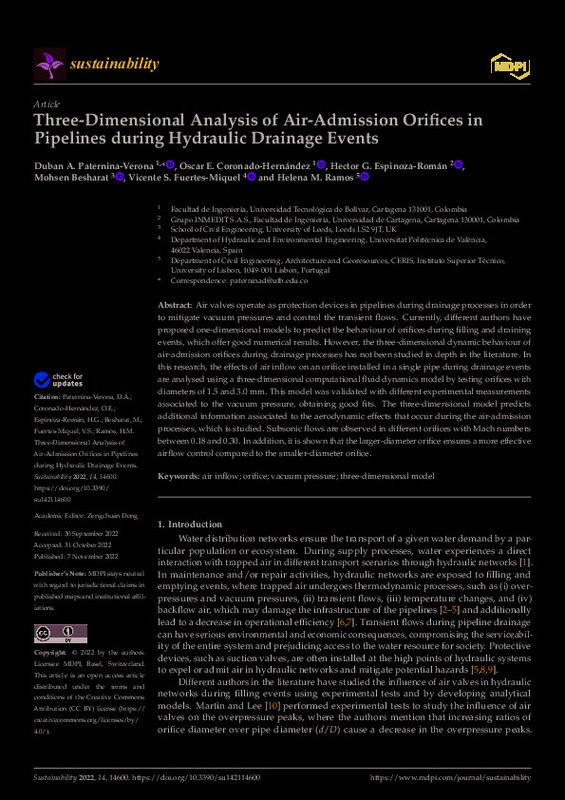JavaScript is disabled for your browser. Some features of this site may not work without it.
Buscar en RiuNet
Listar
Mi cuenta
Estadísticas
Ayuda RiuNet
Admin. UPV
Three-dimensional analysis of air-admission orifices in pipelines during hydraulic drainage events
Mostrar el registro sencillo del ítem
Ficheros en el ítem
| dc.contributor.author | Paternina-Verona, Duban A.
|
es_ES |
| dc.contributor.author | Coronado-Hernández, Oscar E.
|
es_ES |
| dc.contributor.author | Espinoza-Román, Héctor G.
|
es_ES |
| dc.contributor.author | Besharat, Mohsen
|
es_ES |
| dc.contributor.author | Fuertes-Miquel, Vicente S.
|
es_ES |
| dc.contributor.author | Ramos, Helena M.
|
es_ES |
| dc.date.accessioned | 2023-06-08T18:00:52Z | |
| dc.date.available | 2023-06-08T18:00:52Z | |
| dc.date.issued | 2022-11 | es_ES |
| dc.identifier.uri | http://hdl.handle.net/10251/193989 | |
| dc.description.abstract | [EN] Air valves operate as protection devices in pipelines during drainage processes in order to mitigate vacuum pressures and control the transient flows. Currently, different authors have proposed one-dimensional models to predict the behaviour of orifices during filling and draining events, which offer good numerical results. However, the three-dimensional dynamic behaviour of air-admission orifices during drainage processes has not been studied in depth in the literature. In this research, the effects of air inflow on an orifice installed in a single pipe during drainage events are analysed using a three-dimensional computational fluid dynamics model by testing orifices with diameters of 1.5 and 3.0 mm. This model was validated with different experimental measurements associated to the vacuum pressure, obtaining good fits. The three-dimensional model predicts additional information associated to the aerodynamic effects that occur during the air-admission processes, which is studied. Subsonic flows are observed in different orifices with Mach numbers between 0.18 and 0.30. In addition, it is shown that the larger-diameter orifice ensures a more effective airflow control compared to the smaller-diameter orifice. | es_ES |
| dc.description.sponsorship | This research was funded by grant No. INV03CI2214 of the Universidad Tecnologica de Bolivar. | es_ES |
| dc.language | Inglés | es_ES |
| dc.publisher | MDPI AG | es_ES |
| dc.relation.ispartof | Sustainability | es_ES |
| dc.rights | Reconocimiento (by) | es_ES |
| dc.subject | Air inflow | es_ES |
| dc.subject | Orifice | es_ES |
| dc.subject | Vacuum pressure | es_ES |
| dc.subject | Three-dimensional model | es_ES |
| dc.subject.classification | MECANICA DE FLUIDOS | es_ES |
| dc.title | Three-dimensional analysis of air-admission orifices in pipelines during hydraulic drainage events | es_ES |
| dc.type | Artículo | es_ES |
| dc.identifier.doi | 10.3390/su142114600 | es_ES |
| dc.relation.projectID | info:eu-repo/grantAgreement/UTB//INV03CI2214/ | es_ES |
| dc.rights.accessRights | Abierto | es_ES |
| dc.contributor.affiliation | Universitat Politècnica de València. Escuela Técnica Superior de Ingenieros Industriales - Escola Tècnica Superior d'Enginyers Industrials | es_ES |
| dc.description.bibliographicCitation | Paternina-Verona, DA.; Coronado-Hernández, OE.; Espinoza-Román, HG.; Besharat, M.; Fuertes-Miquel, VS.; Ramos, HM. (2022). Three-dimensional analysis of air-admission orifices in pipelines during hydraulic drainage events. Sustainability. 14(21):1-14. https://doi.org/10.3390/su142114600 | es_ES |
| dc.description.accrualMethod | S | es_ES |
| dc.relation.publisherversion | https://doi.org/10.3390/su142114600 | es_ES |
| dc.description.upvformatpinicio | 1 | es_ES |
| dc.description.upvformatpfin | 14 | es_ES |
| dc.type.version | info:eu-repo/semantics/publishedVersion | es_ES |
| dc.description.volume | 14 | es_ES |
| dc.description.issue | 21 | es_ES |
| dc.identifier.eissn | 2071-1050 | es_ES |
| dc.relation.pasarela | S\488670 | es_ES |
| dc.contributor.funder | Universidad Tecnológica de Bolívar | es_ES |








